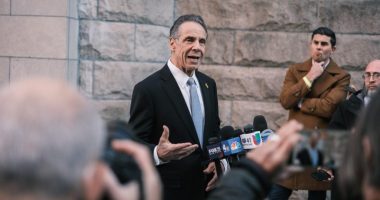
The nine Supreme Court justices appeared divided Wednesday over whether to nix a ban on bump stocks — attachments to enhance the firing pace of semi-automatic rifles — implemented by former President Donald Trump.
The 45th president’s administration banned the devices following the Oct. 1, 2017, mass shooting at a country music festival in Las Vegas that killed 60 people and wounded hundreds more. Investigators found that the gunman employed weapons equipped with bump stocks and high-capacity magazines to fire more than 1,000 rounds in 11 minutes.
Michael Cargill, a Texas gun store owner, challenged the ban, and three separate appeals courts have issued different rulings on whether the regulation should stand.
Wednesday’s argument turned on whether guns with a bump stock can be considered illegal machine guns under federal law, with the Biden Justice Department saying they could and attorneys for Cargill saying the attachments did not change the weapons’ core function enough to make them illegal.
Conservative justices raised questions about whether machine-gun laws dating to the 1930s applied to bump stocks and about the Justice Department’s previous determination that the accessories were legal.
“Intuitively, I am entirely sympathetic to your argument,” Justice Amy Coney Barrett told Principal Deputy Solicitor General Brian Fletcher, arguing for the government. “I think the question is, why didn’t Congress pass that legislation to make this cover it more clearly?”
The liberal justices indicated they saw the ban as perfectly in keeping with past firearm regulation.
“I view myself as a good textualist,” Justice Elena Kagan, who famously went hunting with the late Justice Antonin Scalia, explained at one point. “Textualism is not inconsistent with common sense
.”
Kagan added it was reasonable to conclude a law restricting machine guns applies to a weapon that “fires a multitude of shots with a single human action.”
Bump stocks are typically used to replace the buttstock of a rifle and entail the bumping of the trigger against one’s finger rather than pulling it. Very little force can trigger a gun with a bump stock, so the kinetic energy from reloading can activate rapid fire when a bump stock is attached to a semi-automatic gun while the shooter keeps pressure on the barrel.
The Trump administration announced the bump stock ban under the National Firearms Act of 1934, which was enacted in the wake of widespread violence perpetuated by outlaws like John Dillinger.
“I can certainly understand why these items should be made illegal,” said conservative Justice Neil Gorsuch, “but we’re dealing with a statute that was enacted in the 1930s.”
“And through many administrations, the government took the position that these bump stocks are not machine guns.”
Fletcher countered that the Bureau of Alcohol, Tobacco, Firearms and Explosives (ATF) assessed the application of the law more carefully in the wake of the Las Vegas tragedy.
“I think it would have been irresponsible for the ATF not to take another look at this prior interpretation,” he said.
Another conservative justice, Brett Kavanaugh, did not appear convinced by that explanation, telling Fletcher that keeping the new regulation in place was “going to ensnare a lot of people who are not aware of the legal prohibition.”
On the other side, Kagan grilled Jonathan Mitchell, the lawyer arguing Cargill’s case.
“This statute is loaded with anti-circumvention devices,” she stressed. “The entire way the statute is written suggests that Congress was very aware that there could be small adjustments of a weapon that could get around what Congress meant to prohibit.”
Mitchell disputed comparisons between bump stocks and machine guns.
“Everything about the bump firing process is manual,” he argued. “And there is no automating device such as a spring or a motor in any of Mr. Cargill’s nonmechanical bump stocks.”
In 2019, the high court opted against consideration of a challenge to the bump stock ban. Since then, the court was shifted to the right with the appointment of Barrett to replace the late Ruth Bader Ginsburg.
The high court has handed down a number of favorable decisions to gun rights activists in recently. In 2022, the Supreme Court struck down a century-old New York law restricting the concealed carrying of handguns.
This past November, however, the high court seemed skeptical of scrapping gun laws restricting individuals accused of domestic violence from getting firearms.
Both the 5th US Circuit Court of Appeals and the 6th US Circuit Court of Appeals concluded the federal ban on bump stocks was illegal. However, the US Court of Appeals for the District of Columbia Circuit upheld the policy.
A decision in the case, Garland v. Cargill, is expected by the end of June.








